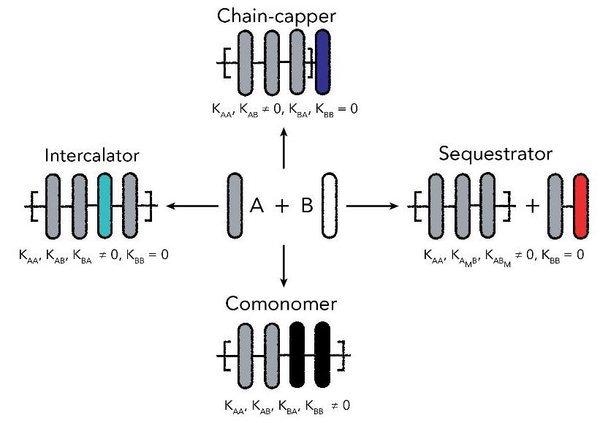Reviewed by Alex SmithSep 22 2021
Researchers are familiar with details regarding the systems made of one supramolecular polymer, but they are yet to understand those with the combination of multiple supramolecular polymers; for example, the factors that affect the length of the resulting copolymers.
 Illustration of how adding a second supramolecular polymer can affect the length of the copolymer. Image Credit: Eindhoven University of Technology.
Illustration of how adding a second supramolecular polymer can affect the length of the copolymer. Image Credit: Eindhoven University of Technology.
Elisabeth Weyandt, as part of her PhD research, analyzed the way the length of the copolymers can vary. Weyandt defended her thesis at the Department of Chemical Engineering and Chemistry on September 17th, 2021.
Conventional polymers, such as the ones used in plastics, include monomers that are combined by covalent bonds. By contrast, in supramolecular polymers, the aspects are a little different as monomers are connected by a combination of weaker, non-covalent bonds such as hydrogen bonding or π-π stacking.
Although single-component supramolecular polymer systems are well understood, it has been difficult to move from single to multi-component systems to achieve functional supramolecular materials and systems.
When many supramolecular components are mixed, the aggregate length is affected. This results in the variation in the characteristics of the material.
Adding a Second Supramolecular Polymer
Weyandt, as part of her PhD, investigated, for the first time, the effects on copolymer length results due to the addition of a second supramolecular polymer. The second component can lead to several effects.
Initially, it could serve as a commoner that increases the length. Secondly, it could be an intercalator that squeezes between two monomers. Thirdly, it can act as a sequestrator that negatively influences the single monomers and decreases the count of available monomers.
Finally, it can serve as a chain-capper capable of blocking the chain end and preventing any increase in the length of the polymers.
In her thesis, Weyandt highlights the challenges faced in measuring the length of the dynamic polymers, as well as examining the role played by additives in the process.
An important observation from the study was that the total monomer concentration has a major influence on the impact of the second polymer in controlling the length of the copolymer.
When working at high concentrations, the efficiency is higher than at low concentrations. This is counterintuitive, provided that the composition of monomers is the same.
Light Irradiation
Weyandt analyzed many cases with supramolecular mixtures. In one instant, she used a photoswitchable additive, which is an additive capable of changing from being an intercalator to a chain-capper by irradiating it with light. The additive was then reversed to the intercalator state by thermal relaxation.
The formation of a covalent bond between the supramolecular monomers provides their distinct, dynamic properties. However, they also pose challenges in resolving the mechanism behind these changes.
With the work in her thesis, Weyandt was able to broaden the basic understanding of supramolecular copolymers and the subtle balance of interaction that facilitates the structure formation in complex, multi-component supramolecular systems.